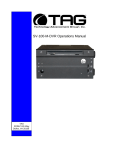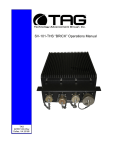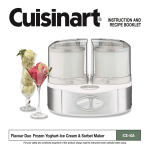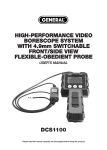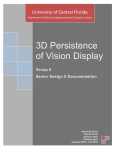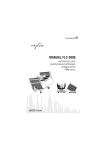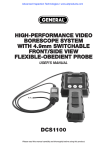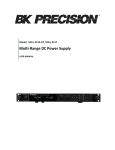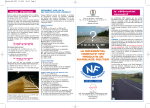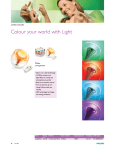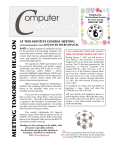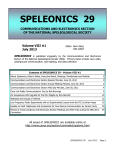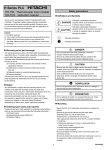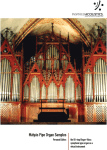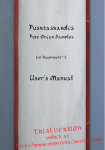Download XV International PhD Workshop OWD 2013, 19–22 October 2013
Transcript
XV International PhD Workshop OWD 2013, 19–22 October 2013 Development of a custom retro game console Nóra Haláchy BSc student, Viktor Devecseri PhD student, Péter Korondi DSc, Budapest University of Technology and Economics Abstract In this paper the development of a complex mechatronic product through the example of a custom retro game console including the integration of the electronic components, programming, and manufacturing is presented. There is an overview and a comparison of the available components. As a result of this comparison the best components can be chosen to the game console. Through the explanation of the functional block diagram the functionality of the device can be easily explained. Beyond the electrical part a minimal framework for game and application programming is presented. Finally some highlights about how an idea evolved into a real product through design and construction is shown. system on a chip, which includes an ARM 700 MHz processor. Model B has 512 MB of RAM, it uses an SD card for booting and long term storage. 1. Intro Fig. 1. Raspberr y Pi (Mod el B) Recently, the goal for the manufacturers of the games is to achieve maximum gaming experience using maximum technical parameters. Now games can be played in 3D, or in very high resolution, which results in very realistic games, but we think the maximum gaming experience doesn’t depend on the technical parameters. In opinion, the gameplay is up to the game’s atmosphere. In spirit of this our product was developed, and the goal was to provide classic games such as Snake. Simple games, but unique gaming experience is guaranteed. This product is completely developed by us, and consists of a game controller, an 8x10 LED matrix, and a central logic unit. This kind of game controller can’t be found commercially. 1.1 Available components Choosing the right microcontroller was the first step, because this can strongly influences the course of the development and the outcome too. Taking into account the project’s specialties three boards are found to be suitable for the final construction. 1.1.1 Raspberry Pi (Model B) The Raspberry Pi is a credit card sized singleboard computer (Fig. 1.), has a Broadcom BCM2835 It has 8 GPIO pins, +5V, +3,3V, ground, but even if the 700MHz [1] clock speed is amazing, the 8 GPIO pins is not enough for this project. The TLC5940 LED driver needs 5 pins, and one controller has at least 4 pushbuttons. Connecting more than one controller to the Raspberry Pi is harder because the number of available GPIO pins. The Raspberry Pi can run different operation systems for free, such as Linux, Raspbian. For prototyping another board can be more efficient without an operation system. 1.1.2 PIC boards EasyPIC boards were equipped with PIC16 chip [3], but this new version (EasyPIC v7) is equipped with PIC18. It has 16 MIPS operation, 64K bytes of linear program memory, 3896 bytes of linear data memory, and support for a wide range of power supply from 1.8V to 5V. It’s loaded with great modules: 36 General purpose I/O pins, 30 Analog Input pins (AD), Digital-To-Analog Converter (DAC), support for Capacitive Touch Sensing using Charge Time Measurement Unit (CTMU), three 8bit timers and four 16-bit timers. It also has pair of CCP, Comparators and MSSP modules (which can be either SPI or I2C). 302 assist the development. On the other hand, there are plenty of pins to use, and this structure of the hardware and software is ideal for this type of prototyping. Tab. 1. Comparison of t he available boards Arduino Mega2560 Clock spd RAM Pins Price Fig. 2. Easy PIC v7 By using this board the developer has a bunch of opportunity. In this board there is a built in Liquid Chrystal Display, LEDs, buttons, 7-segment display, and of course a lot of other sensors and output devices (Fig.2.). 1.1.3 Arduino Arduino is an open-source electronics prototyping platform based on flexible, easy-to-use hardware and software. It's intended for artists, designers, hobbyists and anyone interested in creating interactive objects or environments. 16 MHz 256 Kb 54 39 EUR PIC EasyPIC v7 20 MHz 64 Kb 36 113 EUR Raspberry Pi Model B 700 MHz 256 Mb 14 27 EUR Now, we know which will be the brain of the game controller, let’s see the other parts. The other main parts are presented on Fig. 4. In the second chapter the details of the electrical part will be shown, including the hardware. In the third chapter the software part will be discussed, and then in the fourth chapter the physical implementation of the construction will be presented. In the end there will be a short summary of the whole project. Controller Arduino LED driver LED matrix Fig. 4. Overview 2. Electronics On Fig. 5 the functional block diagram is shown. The controlling unit is an Arduino board, which is controlling the LED drivers. In contrary the illustration, there are 5 LED drivers in the real circuit. Fig. 3. Arduino Mega 2560 The microcontroller on the board is programmed using the Arduino programming language (based on Wiring) and the Arduino development environment (based on Processing). Arduino projects can be stand-alone or they can communicate with software running on a computer (e.g. Flash, Processing). One of the most popular boards is the Arduino Mega 2560 (Fig. 3.). It has 54 digital I/O pins [2], of which 15 provides PWM, 16MHz clock speed, and 256 KB flash memory. 1.2 Conclusion As in the previous sections it has also been presented, these boards provide a very wide range of opportunities for technical terms (Tab. 1.). To make this into a successful project, appropriate software, and support is required too. Thus, the choice have fallen on the Arduino board, because of the existing libraries, discussion forums, sample programs to Fig.5. The fu nctional block diagram of t he s yst em The TLC 5940 (Fig. 6.) is a 16 channel constantcurrent sink LED driver. It has a 12 bit (4096 steps) grayscale PWM control, and a 6 bit (64 steps) dot 303 correction. LED power supply voltage is up to 17 V, communicates via Serial Data Interface [4]. NT PACKAGE (TOP VIEW) OUT1 1 28 OUT0 OUT2 2 27 VPRG OUT3 3 26 SIN OUT4 4 25 SCLK OUT5 5 24 XLAT OUT6 6 23 BLANK OUT7 7 22 GND OUT8 8 21 VCC OUT9 9 20 IREF OUT10 10 19 DCPRG OUT11 11 18 GSCLK OUT12 12 17 SOUT OUT13 13 16 XERR OUT14 14 15 OUT15 control the LED driver. The LED matrix library controls the LEDs through the TLC library. The Controller library makes easier to get information about each button’s state. Using a pushbutton the bounce button phenomenon needs to be avoided. With the controller library the button state is only a boolean variable, which value is debounced by processing the button events. 3.1. Fig. 6. Chann els of th e LED dr iver [4 ] This device makes it possible to control 16 LEDs using 5 pins (not counting the VCC and GND) in the Arduino board. It’s possible to chain these drivers if more than one is needed. In this case the number of requested pins on the Arduino is not increasing, but the number of the connected LEDs are increased. The controller contains 8 pushbuttons, and one LED for checking the connection with the Arduino board. This LED is turned on, if the controller is connected to the board. For the LED matrix we used blue 3 mm LEDs. Luminous intensity is between 3000 and 4000 millicandelas. The beam angle is 20°, so one LED’s luminous flux can be easily calculated. The number of lumens (lm) per LED is 0,38. Game logic After the initialization the game’s main loop starts. The first task is to check the input via the Controller library. If there is any input, the program handles it, and the internal state of the game is updated. If there isn’t any event from the user, the game’s internal state will be also updated (for example the snake is moving forward naturally without interruption). Then the display will be refreshed, which means that the output (the LED matrix) will be physically refreshed, and the internal state will be the same as the external. 4. Physical implementation The main material of the body and the controller is wood. On Fig. 8 one moment of the Snake game is shown. Behind the white plastic planes there are blue LEDs. Owing to the small white plastic planes, each LED provides a homogenous, diffuse light. At the bottom there is an “N” character. This is lighten if the game controller is switched on, and it’s dark, if it’s switched off. This is a feedback to the user and a design element too. 3. Software Hardware Software On Fig 7. the software architecture is shown. The darker cells are implemented by us, and the white cells are open source components. Fig 8. Main body concept Fig. 7. The archit ectur e of th e software To use the hardware of Arduino, Wiring gives an easy to use Object Orientated interface (for example easier handling of pins, timers, PWM etc.). The TLC library hides the details of the SDI communication, and provides a simpler interface to 304 not in use. Furthermore built in speakers, and sound effects can increase the gaming experience. 6. Bibliography [1] Raspberry Pi: http://www.raspberrypi.org/, the official page of the Raspberry Pi [2] Arduino: Official Arduino page, http://www.arduino.cc [3] Mikroelektronika: EasyPIC v7 user manual, http://www.mikroe.com [4] Texas Instruments: TLC5940NT datasheet, http://www.ti.com/lit/ds/symlink/tlc5940.pdf [5] Efunda: Laminated Object Manufacturing, http://www.efunda.com/processes/rapid_prot otyping/lom.cfm Fig. 9. Controller conc ept The controller (Fig. 9.) is made with LOM (Laminated Object Manufacturing). This is a rapid prototyping system [5]. First the appropriate shape must be cut. The body is divided by layers. In one step only one layer can be made, so the whole body will be ready, if the layers are glued together successfully. For cutting the layers we used a laser cutter machine. Then the layers need to be skived together, so this way the edges of the individual layers can be hided. Authors: Nóra Haláchy Budapest University and Technology and Economics Bertalan Lajos Street 4-6 1111 Budapest tel. +36 1 463-2602 fax +36 1 463-3787 email: [email protected] MSc. Viktor Devecseri Budapest University and Technology and Economics Bertalan Lajos Street 4-6 1111 Budapest tel. +36 1 463-2602 fax +36 1 463-3787 email: [email protected] Fig. 10. The display with th e controller The main body’s physical size will probably approach an average television (Fig. 10.), but not with 16:9 aspect ratio, it’s around 4:3. The controller is almost the same size with the other existing game controllers in the market. 5. Summary This project needed a lot of knowledge and experience from different areas, and it’s started totally from zero. In a few weeks from blueprints, and schematics it’s became something real, something concrete. The point was to make something simple, but giving high gaming experience. We reached our goal and we hope other people will enjoy this game too. In the future we’d like to make a little bit bigger display with RBG LEDs, and make the body foldable, and saving place, when the game console is 305 DSc. Péter Korondi Budapest University Technology and Economics Bertalan Lajos Street 4-6 1111 Budapest tel. +36 1 463-2602 fax +36 1 463-3787 email: [email protected] and




